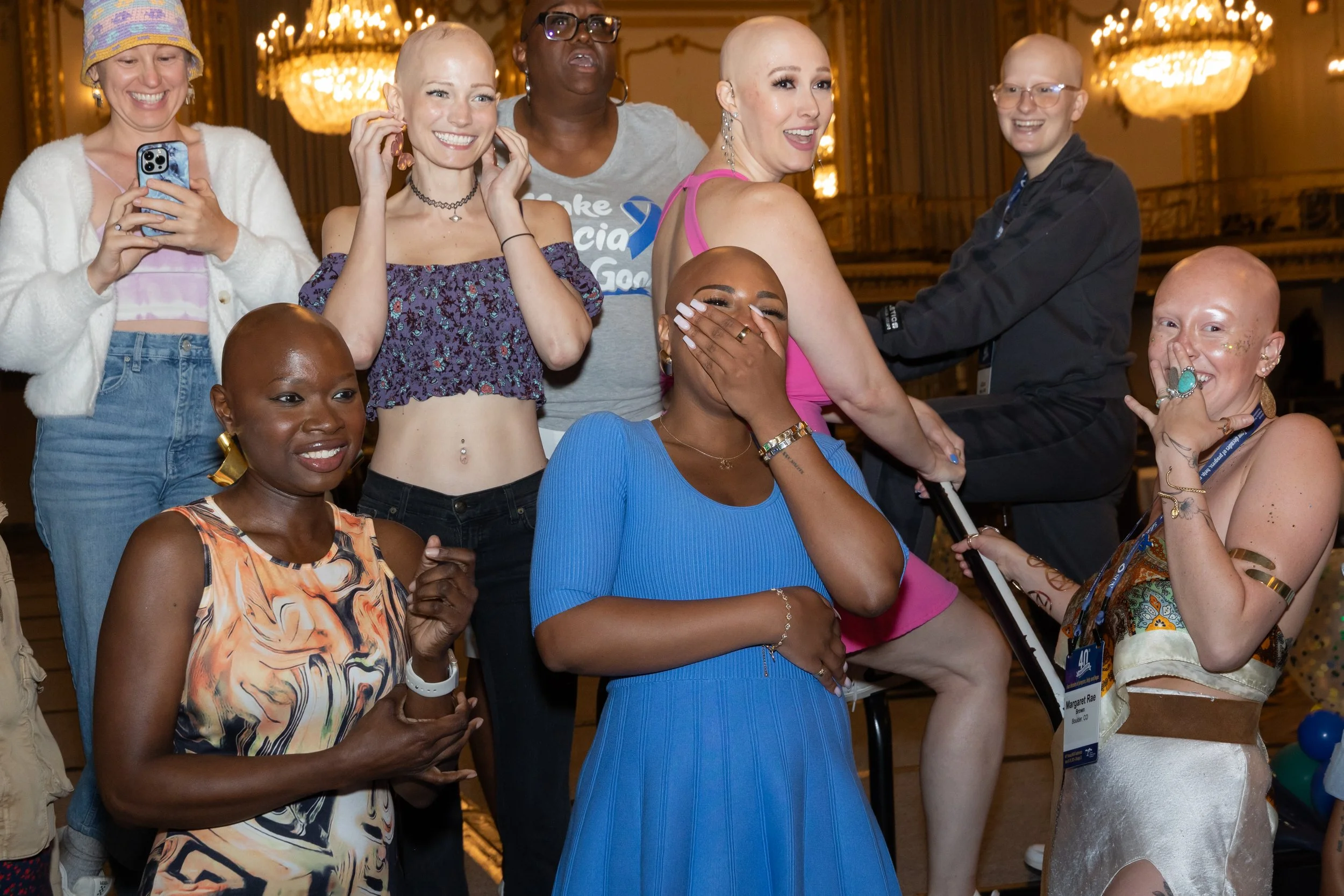What Does Alopecia Mean? A practical, compassionate guide to hair loss
If you’ve ever Googled “what does alopecia mean?” in a moment of panic—deep breath, you’re not alone. And you’re definitely not broken.
Let’s start with the basics: “Alopecia” is just the medical term for hair loss. That’s it. Just a word doctors use when talking about hair falling out.
As someone who was diagnosed with alopecia areata at the age of 3, I’ve lived through the confusion, the awkward questions (“Did you cut your hair like that on purpose?”, “What type of cancer do you have?”) and the grief that hair loss can bring. Now, as a therapist and hair loss coach, I support people navigating these same emotions and identity shifts—so they can live a full, confident life, no matter how much hair they have.
Let’s demystify this whole alopecia thing together and review some of the main types of Alopecia.
So... What Does Alopecia Mean?
Alopecia = hair loss. That’s it. In other words, mostly everyone will experience Alopecia at some point.
It doesn’t tell you why hair is falling out or whether it’ll grow back—it’s just the umbrella term. The real answers come from looking at the type of alopecia you’re dealing with.
Here are the most common types, starting with the one I know best…
1. Alopecia Areata (and Its Many Forms)
Alopecia areata is an autoimmune condition where your immune system mistakenly attacks your own hair follicles. It’s not contagious, not caused by stress (despite the myths), and not your fault. I sometimes describe to people as similar to the body having an allergy to hair.
It comes in several types—some more well-known than others:
→ Patchy Alopecia Areata
This is the classic version and often how it starts for most people: small, smooth, round (or oval) bald patches that show up suddenly, most commonly on the scalp. Some people may only ever have one or two spots. Others might experience recurring patches that come and go over time.
It’s often unpredictable—regrowth can happen, but so can new patches.
→ Diffuse Alopecia Areata
Instead of distinct bald patches, diffuse alopecia areata causes sudden, even thinning across the scalp. It can sometimes be mistaken for telogen effluvium or female-pattern thinning—but the rapid onset and autoimmune nature set it apart. This is a more rare form of alopecia areata that is not talked about as often.
This version can feel extra scary because it’s subtle at first—but know that you’re not imagining it, and you deserve support no matter what it looks like.
→ Alopecia Totalis
This is a more advanced form of alopecia areata where there’s complete loss of scalp hair, but the person still has other facial and body hair.
→ Alopecia Universalis
This is the rarest and most extensive version—total loss of all hair on the body, including scalp, brows, lashes, and body hair. While it can feel overwhelming, it's not dangerous to your physical health. As I used to tell my classmates in elementary school “I can still do everything you guys can do!” to explain the fact that alopecia areata did not impact any of my functioning health-wise.
2. Androgenetic Alopecia
Also known as male-pattern or female-pattern baldness, this one is often genetic and hormone-driven. It usually shows up gradually—thinning on the crown, widening part lines, or receding hairlines.
It's common, especially as we age, and has a different cause and progression from autoimmune types like alopecia areata.
3. Telogen Effluvium
This one often follows physical or emotional stress, illness, surgery, or hormonal shifts (like postpartum). Your hair suddenly shifts into the resting phase and sheds more than usual—sometimes in handfuls.
4. Traction Alopecia
This happens from consistent pulling on the hair—think tight ponytails, braids, wigs, or extensions. Over time, tension damages follicles. If caught early, it can be reversed. But if the pulling continues too long, hair loss can become permanent in those areas.
5. Cicatricial (Scarring) Alopecia
Scarring alopecia is an inflammatory condition where inflammation destroys hair follicles and replaces them with scar tissue, meaning the hair loss can be permanent. It often requires a dermatologist for diagnosis and treatment.
If you’re noticing burning, itching, or tenderness along with hair loss, definitely get it checked out.
So... What Now?
Hair loss can be so much more than cosmetic. It can shake your sense of identity, bring up grief, or trigger anxiety you never expected. And if you're thinking, “This shouldn't be such a big deal,” but you’re still having immense feelings seeing hair come out in the shower or seeing a new version of yourself in the mirror—let me gently say: it is a big deal. And your feelings are valid.
But here's what else is true:
👉 You are not broken.
👉 You’re not alone.
👉 And you don’t have to figure it all out by yourself.
Whether you’ve just noticed a patch, are in the middle of a shedding storm, or have been dealing with hair loss for years, support is available. As a licensed therapist and hair loss coach who’s been in your shoes, I combine emotional support with practical tools to help you navigate this journey with more confidence, clarity, and self-compassion.
📅 Book a free consultation and we can discuss about how therapy or coaching can support your journey through hair loss and back to self. (or I can offer you other resources as well!)
You are still whole. Still worthy. And still allowed to want joy, confidence, and freedom—even if your hair has other plans.

